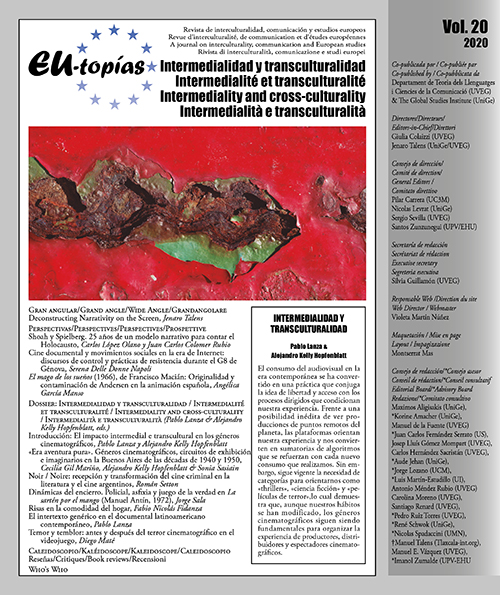The Generic Intertext in Contemporary Latin American Documentary
DOI:
https://doi.org/10.7203/eutopias.20.19393Keywords:
Documentary film, film genres, hybridization, Latin America, intertext. Abstract
Abstract
In the last decades, studies on documentary cinema have emphasized the progressive blurring of borders with fiction works and characterized such productions as hybrid objects. Even though the borders between the two domains were never as rigid as it is often pointed out, it is true that a high degree of stylization has become a constant feature in contemporary documentary film. This article analyzes a number of Latin American documentaries produced in the last two decades by taking into account the dialogue the films establish with different cinematographic genres: horror cinema, road movie and film noir. The appropriation of narrative structures, procedures and iconographies of the different genres provides documentaries with a series of key tools for the articulation of personal and collective stories.
 Downloads
Downloads
 References
References
Altman, Rick. Los géneros cinematográficos. Barcelona: Paidós, 2000.
Arenillas, María Guadalupe & Michael J. Lazzara. «Introduction: Latin American Documentary Film in the New Millennium». Latin American Documentary Film in the New Millennium. Eds. Arenillas, María Guadalupe & Michael J. Lazzara. New York, Palgrave Macmillan, 2016, pp. 1-19.
Bernardet, Jean-Claude. «Documentales de búsqueda: 33 y Pasaporte húngaro». El cine de lo real. Eds. Labaki, Amir & María Dora Mourão. Buenos Aires: Colihue, 2011, pp- 117-128.
Chanan, Michael. «The Space between Fiction and Documentary in Latin American Cinema: Notes toward a Genealogy». Visual Synergies in Fiction and Documentary Film from Latin America. Ed. Haddu, Miriam & Joanna Page. New York, Palgrave Macmillan, pp. 15-24.
Corrigan, Timothy. A Cinema without Walls. Movies and Culture after Vietnam. Londres-New York, Routledge, 1991
Flaherty, Robert. «La función del documental». Textos y manifiestos del cine. Ed. Romaguera i Ramió & Homero Alsina Thevenet. Madrid, Cátedra, 1993, pp. 139-147.
Hill, Annette. Restyling Factual TV. News, Documentary and Reality Television. New York, Routledge, 2007.
Jameson, Fredric. «Globalization and hybridization». World Cinemas, Transnational Perspectives. Ed. Ďurovičová, Natasa & Kathleen Elizabeth Newman. Londres-New York, Routledge, 2010, pp. 315-319.
Lebow, Alisa. «The unwar film». A Companion to Contemporary Documentary Film. Ed. Juhasz, Alexandra & Alisa Lebow. Oxford, Wiley Blackwell, 2015, pp. 454-474.
Lie, Nadia & Pablo Piedras. «Identidad y movilidad en el cine documental latinoamericano contemporáneo: Familia tipo (2009) e Hija (2011)». Confluencia, Vol. 30, N° 1, 2014, pp. 72-86. https://doi.org/10.1353/cnf.2014.0009 Recuperado el 10 de octubre de 2020.
Link, Daniel. «El juego silencioso de los cautos». El Juego de los Cautos. La literatura policial: De Poe al caso Giubileo. Comp. Link, Daniel. Buenos Aires, La marca editoria, 1992, pp. 5-11.
Miller, Carolyn R. «Genre as social action» Quarterly Journal of Speech, 70, 1984, pp. 151-167. Recuperado el 10 de octubre de 2020.
Niney, François. La prueba de lo real en la pantalla: ensayo sobre el principio de realidad documental. México, UNAM-CUEC, 2009.
Orgeron, Devin. Road Movies. From Muybridge and Méliès to Lynch and Kiarostami. New York, Palgrave Macmillan, 2008.
Pavés, Gonzalo M. El cine negro de la RKO. En el corazón de las tinieblas. Madrid, T&B Editores, 2003.
Piedras, Pablo. «The Contemporary Documentary Road Movie in Latin America: Issues on Mobility, Displacement, and Autobiography». The Latin American Road Movie. Ed. Verónica Garibotto & Jorge Pérez. New York: Palgrave Macmillan, 2016.
Piedras, Pablo. El cine documental en primera persona. Buenos Aires, Paidós, 2014.
Rancière, Jacques. La fábula cinematográfica. Reflexiones sobre la ficción en el cine. Barcelona: Paidós, 2005.
Sobchack, Thomas. «Genre Film: A Classical Experience». Film Genre Reader II. Ed. Barry Keith Grant. Austin: University of Texas Press, 1995, pp. 114-128
Staiger, Janet. « Hybrid or Inbred: The Purity Hypothesis and Hollywood Genre
History». Film Genre Reader IV. Ed. Barry Keith Grant. Austin: University of Texas Press, 2012, pp. 203-217
Vernet, Marc. «Film noir on the Edge of Doom». Shades of Noir. A reader. Ed. Copjec, Joan. Londres-New York, Verso, pp. 1-32.
Vertov, Dziga. «Nosotros (variante del Manifiesto)». Textos y manifiestos del cine. Ed. Romaguera i Ramió & Homero Alsina Thevenet. Madrid, Cátedra, 1993, pp. 37-40.
Downloads
Published
How to Cite
-
Abstract326
-
PDF (Español)208
Issue
Section
License
![]()
The authors conserve the copyright. All content published in EU-topías. Journal of interculturality, Communication, and European Studies are subject to the license Creative Commons Attribution-NonCommercial-ShareAlike 4.0 license. The full text of the license can be found at <http://creativecommons.org/licenses/by-nc-sa/4.0>
They may be copied, used, disseminated, transmitted and publicly displayed, provided that:
- The authorship and original source of the publication is cited (journal, publisher and URL of the work).
- They are not used for commercial purposes.
- The existence and specifications of this license of use are mentioned.
It is the responsibility of the authors to obtain the necessary permissions for images that are subject to copyright.



